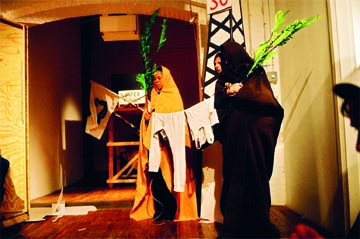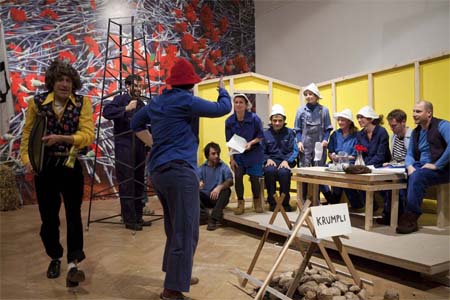Context & Identity in Contemporary Hungarian Art
Reimagining the near past and constructing local identities. A Fulbright project by Linnea West (2012-13)
Meeting with Gergely László

When I was in Berlin in March, I met with Hungarian artist Gergely László, who moved there last fall. László’s project on Yad Hanna, a kibbutz in Israel founded by Hungarians in the 1950s, takes a disparate approach to exploring the different facets of this community from its founding until the present day. His work takes multiple forms: first, in 2008, he went to live on the kibbutz and created an archive. Secondly, he took this archival material as inspiration for a play The Collective Man, which has been performed at International Studio and Curatorial Program (ISCP) in New York, in Budapest as part of an exhibition at the Ernst Museum, and at the Witte de With in Rotterdam. The narrative revolves around Israel’s best-known communist kibbutz whose founders include the younger sister of László’s maternal grandmother as well as her husband.

Over time the community has changed dramatically. Walking through the now-privatized land, László first began documenting the changes to the architecture, manifestations of how people build when they are sole owners of a property compared to when they live communally. The population of the kibbutz has changed as well. A few founding members still live there, such as László’s relatives, as do refugees and migrant workers from parts of the world as diverse as Thailand and Sudan. In addition to these photo series that he made, the artist began collecting photos from older members of the community in an unused bunker, asking about the stories behind them. Ultimately, the result is a rich, thematised collection of 1,200 photos he finally presents as an archive, both in two large metal boxes (which remain at Yad Hanna) and as a keyword-searchable database. The process of building the archives and going through hundreds of photos was how László learned the history of the Yad Hanna and communal life, its struggles and failures and eventual dispersion, as children moved away from the lifestyle their parents had created. Although it was a family connection that first brought László to the kibbutz, his perspective is not nostalgic.


This archive provided the material for another project, a play representing different levels of Yad Hanna’s history and social life. Inspired by photos of Purim plays in the archives, and all the inventiveness and energy that went into the community’s skits produced for this Jewish holiday, László scripted The Collective Man. The basic structure is a fairy tale, and the general content of the dialogue is indicated but intended to be improvised by the amateur actors. The setting and characters reference selected elements from the archival images, so that they become emblematic of elements that were of pivotal importance at one time or another. László feels that the complexity of the historical situation was not fully conveyed to the audience of the first performance, and that this was better communicated in The Collective Man’s second performance at the Ernst Museum in 2010 where the exhibition layout provided further documentation. At the Ernst Museum, László was able to unfold elements of the play room by room and lay out the visual material the play was based on, creating a nuanced backdrop that could be explored in more depth. One on hand, this story of the community is a story of a Hungarian diaspora even as it is of a Jewish homecoming. While it was no direct intention of László to represent Hungarian-Jewish identity per se, it is interesting to note how his work makes visible—especially through his show at the Ernst Museum in Budapest—a Jewish aspect of Hungarian identity, which is not common within Hungary.

This work with Yad Hanna is not unconnected to previous projects, such as Home Museum created with Katarina Šević, in which the two dated, numbered, and presented ‘artifacts’ from a personal historical dig—the remains of the Šević family vacation home that had been abandoned because of the Yugoslav wars. László also works in collaboration with Péter Rákosi under the name Tehnica Schweiz. His projects, as well as the ones for Tehnica Schweiz, often deal with how communities function and use photography and archives as mediums. In addition, László has been notably instrumental in Lumen, an art- and community-focused organization in Budapest, beginning as Lumen Photography Foundation in 2002 and morphing to include Lumen Gallery and Café in 2008 and most recently Lumen Grocery and Community Supplier.

Through Yad Hanna, László creates a symbolic view into the role of history and a sense of home outside Hungary’s borders and yet Hungarian. The artist’s re-interpretation of the past highlights the joyous and successful moments of the Purim plays even as it shows in its photo series of the architecture the changes to the original Communist utopia. The legacy of Communism is of course one that also plays out—albeit in a less extreme or experimental way–in Hungary. I find it interesting how a personal interest in a larger historical moment is approached with critical distance, as research-oriented as an anthropologist documenting a disappearing tribe—as perhaps it is fair to say he is. On one hand the orderly archives creates a personal, handmade approach to a vanishing past that speaks to a history made up of a multiplicity of viewpoints and memories; meanwhile the performative nature of the play is kept loose and uncontrolled, an unpredictable collective effort. The collective nature of both match in some sense the spirit of the original community. Through multiple iterations and formats, László highlights the failures of the system as well as its ideal moments of verve and glory in this changed community,yet without reducing the complexity of Yad Hanna’s current and historical state.
